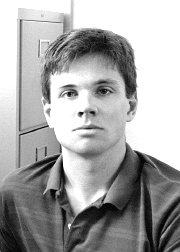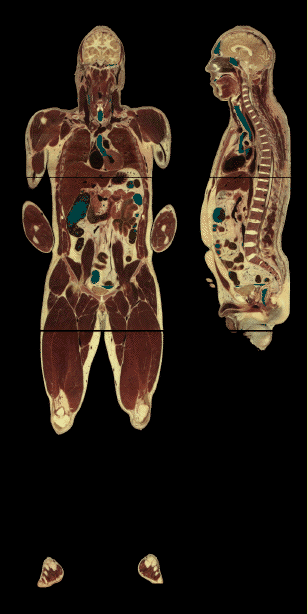
John Clyne. (Photo by Bob Bumpas.)
|

The Visible Man--a three-dimensional, digital data set of male anatomy-- was introduced to the world via the Internet on 28 November. This exhaustive set of imagery was produced through a collaboration of the National Library of Medicine (NLM), the University of Colorado (CU) Health Sciences Center in Denver, and NCAR's Scientific Computing Division. SCD provided computational, networking, and visualization resources and support for the Visible Human Project, a trademarked component of the High Performance Computing and Communications Initiative (HPCC).
"The Visible Man represents an incredibly detailed atlas of human anatomy, created from thousands of images of a human body collected with state-of-the-art radiographic and photographic techniques," explains Donald Lindberg, M.D., director of NLM. The project is managed and funded by NLM, while work has been carried out by researchers at the CU Health Sciences Center.
According to CU's David Whitlock, "The data will be a powerful educational tool for students, and it can also make an important contribution to medical research. Cancer researchers, for example, might be able to plot precise anatomical locations of abnormal cell growth in the Visible Man and use mathematical models to predict how a cancer grows in the body." The data will also be helpful in planning surgery, designing artificial hips and other human-created body parts, and testing various types of medical treatments, the researchers said.
"NCAR has two different roles in this project," explains John Clyne, the project's leader within SCD. "We are providing visualization resources, developed by SCD to support analysis of atmospheric and oceanic data, to help medical personnel study the massive anatomical data set." This was made possible by utilizing SCD's CRAY Y-MP/8 supercomputer, mass storage system, and Silicon Graphics workstations within SCD's Visualization Laboratory.

John Clyne. (Photo by Bob Bumpas.)
"We also are providing the Internet site for the data until the National Library of Medicine can take over this task," adds John. The SCD-based Mass Storage System can hold about 100 terabytes (one trillion bytes) of data. Presently, it has 50 terabytes of information, making it one of the largest archives for computer data in the world. It is growing at a rate of one terabyte per month.
SCD's participation is bringing some interesting benefits back to NCAR. According to Don Middleton-Link, head of SCD's Visualization and Digital Information Group, "We are gaining valuable experience from visualizing the huge medical data set--expertise that we can utilize in the analysis of the large climate, oceanic, and other geoscience-oriented data sets we routinely deal with at NCAR."
The Visible Man was created with digitized data compiled from the body of a 39-year old Texan who had willed his body to science. The donor body was imaged from head to toe using computer tomography, magnetic resonance imagery, and x-rays. It was then embedded in gelatin, frozen, and sliced crosswise into more than 1,000 microslices, using a laser-guided technique pioneered by Victor Spitzer and David Whitlock, both of CU's Health Sciences Center's department of cellular and structural biology.
As each cross-sectional slice was removed from the cadaver, the surfaces were photographed. The digital photographs were stacked and programmed into an imaging computer along with the data acquired from the radiologic studies.
"Reconstructions of the data can be rotated in space, viewed in any plane, dissected, and reassembled," says Spitzer. "Any anatomical part can eventually be extracted from the body and viewed separately. Structures such as blood vessels can be followed throughout the body and their relationship to other structures, such as organs and bones, can be seen."
Lindberg adds, "This is the first time such detailed digital information about an entire human body has been compiled. The Visible Man is so complex that those who wish to access the data [expected to be predominantly medical schools and researchers] will need up to two weeks of uninterrupted Internet time and 15 gigabytes [15 billion bytes] of computer storage space."
There is no charge for accessing the data, but users will be required to sign a licensing agreement with NLM stating how the information will be used. "The Visible Man will be made available for free to those who suggest promising uses for the data and who have sufficient computer storage space," says Michael Ackerman, NLM project coordinator. --Joan Vandiver Frisch, Media Relations
Center for Human Simulation - University of Colorado
Visible Human Project - National Library of Medicine